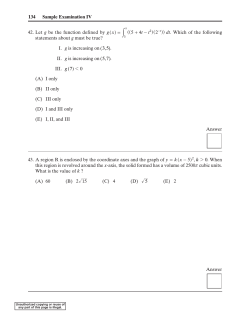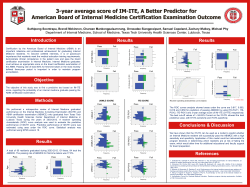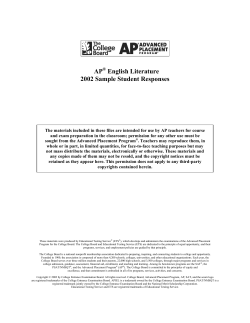
VCE Studio Arts Written examination – November Examination specifications Overall conditions
VCE Studio Arts Written examination – November Examination specifications Overall conditions The examination will be sat at a time and date to be set annually by the Victorian Curriculum and Assessment Authority. There will be 15 minutes reading time and 1 hour 30 minutes writing time. VCAA examination rules will apply. Details of these rules are published annually in the VCE and VCAL Administrative Handbook. The examination will be marked by a panel appointed by the VCAA. The examination will contribute 34 per cent to the Study Score. Content The VCE Studio Arts Study Design 2010–2014 is the primary document for the development of the examination. Unit 3 Outcome 3 and Unit 4 Outcome 3 will be examined. All examination questions will be derived from the key knowledge and key skills in Unit 3 Outcome 3 and Unit 4 Outcome 3. Content will draw on both units and marks allocated will be 40–60%. Format The examination will consist of three sections: Section A, Section B and Section C. All sections and questions are compulsory. The number of questions may vary between 6 and 12 in the examination paper. The total marks for the examination will be 75. The mark allocation for Section A, B and C will be approximately equal on the examination paper. Stimulus images of unseen artworks will be presented in a pull-out insert. The number of colour plates will not exceed 15 plates. Examination questions will be presented in a question and answer book. Answers to Section A, B and C will be recorded in the spaces provided in the book. Advice During the 2010–2014 accreditation period for VCE Studio Arts, examinations will be prepared according to the Examination specifications above. Each examination will conform to these specifications and will test a representative sample of the key knowledge and skills. The following sample examination provides an indication of the type and range of questions teachers and students can expect on the VCE Studio Arts examination paper 2010–2014. The marks allocated to individual questions will vary from year to year. Each question will be followed by lined spaces which will provide a guide of written response anticipated. Further guidance will be provided by the number of marks allocated to each question, which will be clearly stated below each question. The suggested times for the three different sections are: Section A – 30 minutes Section B – 30 minutes Section C – 30 minutes © VICTORIAN CURRICULUM AND ASSESSMENT AUTHORITY 2010 Version 2 – May 2010 Image plates representative of the following artforms and/or media will be selected for inclusion in the examination stimulus material: • drawing • printmaking • ceramics • painting • photography • film and/or video • digital media • design and/or fashion and/or costume design, textiles and fibre • sculpture and/or found object • performance art and/or installation and/or conceptual Section A There will be 2–5 questions referring to a range of visual stimulus material which will be reproduced in the examination paper. This section will require students to apply their understanding of the key knowledge and key skills in answering questions in response to visual stimulus material which will vary from year to year. These questions in the examination will not require responses of great breadth and depth of analysis. The total number of marks allocated for this section can vary between 20 and 30 marks. Section B In this section students are expected to respond in two or more paragraphs. There will be 2–5 questions on a range of written and/or visual stimulus material which will be reproduced on the examination paper. The stimulus material will be reproduced on the final examination paper in black and white or, where appropriate, partial or full colour. Some of the questions may provide scope for choice between varying options for response. The total number of marks allocated for this section can vary between 20 and 30 marks. Section C This section requires students to answer 1–2 extended answer questions. Extended answers can include essays or writing that develops ideas in an expanded form. The total number of marks allocated for this section can vary between 20 and 25 marks. Criteria The following criteria will be used in context to assess the VCE Studio Arts examination paper. 1. using appropriate art language and vocabulary 2. identifying legal obligations and ethical considerations involved in the use of the work of other artists in the making of new artwork 3. describing and comparing the roles of various galleries and other art spaces 4. identifying and discussing methods and considerations involved in presenting, promoting and conserving artworks in a variety of exhibition spaces 5. analysing ways in which artists from different historical and/or cultural contexts undertake artistic practices, employ materials, techniques and processes 6. analysing ways in which artists from different historical and/or cultural contexts develop aesthetic qualities and styles in their artworks 7. understanding ways in which artworks reflect the artists’ interpretation of subject matter, influence cultural contexts and communicate ideas and meanings 8. discussing artists’ practices relating to a particular artform(s) 2010 VCE Studio Arts – Sample examination questions – Version 2 – May 2010 The VCAA does not publish answers to sample examinations. In order to meet copyright requirements some of the images on this website have been omitted. Additional detailed acknowledgements have been inserted for this sample paper only, but will not appear on the November examination paper. 2010 VCE Studio Arts – Sample examination questions – Version 2 – May 2010 Victorian Certificate of Education 2010 SUPERVISOR TO ATTACH PROCESSING LABEL HERE STUDENT NUMBER Letter Figures Words STUDIO ARTS Written examination Day Date 2010 E L Reading time: *.** ** to *.** ** (15 minutes) Writing time: *.** ** to *.** ** (1 hour 30 minutes) P QUESTION AND ANSWER BOOK M A Structure of book Section S A B C Number of questions Number of questions to be answered 3 3 2 3 3 2 Number of marks 28 23 24 Total 75 • Students are permitted to bring into the examination room: pens, pencils, highlighters, erasers, sharpeners and rulers. • Students are NOT permitted to bring into the examination room: blank sheets of paper and/or white out liquid/tape. • No calculator is allowed in this examination. Materials supplied • Question and answer book of 11 pages with a detachable insert in the centrefold. Instructions • Detach the insert from the centre of this book during reading time. • Write your student number in the space provided above on this page. • All written responses must be in English. At the end of the examination • You may keep the detached insert. Students are NOT permitted to bring mobile phones and/or any other unauthorised electronic devices into the examination room. © VICTORIAN CURRICULUM AND ASSESSMENT AUTHORITY 2010 Version 2 – July 2010 2010 STUDARTS EXAM (SAMPLE) Version 2 – July 2010 SECTION A Instructions for Section A You may select the same or a different artwork from the detachable insert for Questions 1, 2 and 3. Answer all questions in the spaces provided. Question 1 Select one artwork from the detachable insert. Discuss how the artist may have used materials and techniques to make the artwork. Artwork number 6 marks SECTION A – continued Version 2 – July 2010 2010 STUDARTS EXAM (SAMPLE) Question 2 Select one artwork from the detachable insert. Choose two art elements from the following list and explain how each contributes to the aesthetic qualities of the artwork. • line, colour, texture, tone, form, shape, movement, light Artwork number Art element 1 Art element 2 5 + 5 = 10 marks SECTION A – continued TURN OVER 2010 STUDARTS EXAM (SAMPLE) Version 2 – July 2010 Question 3 Select one artwork from the detachable insert. Identify and explain three considerations the following public art gallery professionals may respond to when preparing the artwork for permanent display and promoting the artwork to the public. • the curator • the publicity officer Artwork number Curator Publicity officer 6 + 6 = 12 marks END OF SECTION A Version 2 – July 2010 2010 STUDARTS EXAM (SAMPLE) SECTION B Instructions for Section B You may select a new artwork from the detachable insert, or an artwork previously referred to, for Question 4. Answer all questions in the spaces provided. Question 4 Select one artwork from the detachable insert. Analyse how the artist’s interpretation of subject matter contributes to aesthetic qualities and the style of the artwork. Artwork number 8 marks SECTION B – continued TURN OVER 2010 STUDARTS EXAM (SAMPLE) Version 2 – July 2010 Question 5 With reference to artworks you have seen in an exhibition this year explain appropriate conservation methods of • lighting • storage and handling • temperature and humidity control. Exhibition title/description/location • Lighting • Storage and handling • Temperature and humidity control 3 + 3 + 3 = 9 marks SECTION B – continued Version 2 – July 2010 2010 STUDARTS EXAM (SAMPLE) Question 6 Identify an artist who has used the work of another artist to make new artwork. Describe a legal and/or ethical consideration associated with this practice of appropriation. Artist Title of artwork The other artist and aspect of appropriation Legal and/or ethical consideration 6 marks END OF SECTION B TURN OVER 2010 STUDARTS EXAM (SAMPLE) Version 2 – July 2010 SECTION C Instructions for Section C Answer all questions in the spaces provided. Question 7 Discuss how two artists studied this year from different historical or cultural contexts have communicated ideas and meaning in their artwork. Analyse one example of each artist’s work in your response. Artist 1 SECTION C – Question 7 – continued Version 2 – July 2010 2010 STUDARTS EXAM (SAMPLE) Artist 2 6 + 6 = 12 marks SECTION C – continued TURN OVER 2010 STUDARTS EXAM (SAMPLE) 10 Version 2 – July 2010 Question 8 Identify two exhibitions of artworks you have visited in two different exhibition spaces this year. • Describe and compare the exhibition spaces. • Discuss how each exhibition design influenced your viewing of the artworks. SECTION C – Question 8 – continued Version 2 – July 2010 11 2010 STUDARTS EXAM (SAMPLE) 6 + 6 = 12 marks END OF QUESTION AND ANSWER BOOK Version 2 – July 2010 2010 STUDARTS INSERT (SAMPLE) INSERT FOR QUESTIONS 1, 2, 3 AND 6 300 × 400 cm 1. Fernand Léger, (France), The Great Parade, 1954, oil on canvas Due to copyright restrictions, this material is not supplied 180 × 125 × 63 cm 3. Deborah Halpern, (Australia), Cleopatra’s horse, 2001, Ceramic tiles on fibreglass and steel 137 cm × 41 cm 2. Qi Baishi, (China), Prawns and Sagittaria, 1948, ink on paper Deborah Halpern is represented by Mossgreen Gallery, Melbourne and Arthouse Gallery, Sydney TURN OVER 2010 STUDARTS INSERT (SAMPLE) Version 2 – July 2010 37 × 24 cm 4. Käthe Kollwitz, (Germany), The Widow 1, 1923, woodcut on paper Due to copyright restrictions, this material is not supplied height 160 cm 5. Ji Hyun Kim, (Korea) Wedding Dress, 2008, machine and hand sewn, pre-treated linen jacquard, cotton gauze, digitally printed with flower imagery, anti-static polyester lining Traditional Korean bridal gown, Hwal-Ot, 2001, by Ji Hyun Kim, sourced from College of Human Sciences, Iowa State University, http://www.hs.iastate.edu/news/ archives/fcs/news/nn20012002/October/koreanbridal. htm 49 × 33 cm 6. Grant Mudford, (Australia), Dallas 1975, silver gelatin photograph Version 2 – July 2010 2010 STUDARTS INSERT (SAMPLE) Due to copyright restrictions, this material is not supplied 832 × 1000 pixels 7. Matt Hansel (USA), Adam & Eve, digital image, 2003, software and platform: Maya, Poser, photoshop, windows XP height 56 cm 8. David Malangi Daymirringu, (Australia), Gurrmirringu and his wife (pair of figures) c. 1961, natural pigments on wood Licensed by VISCOPY 2010 height 61 cm 9. Exekias, (Greece) Ajax and Achilles Playing Dice, 540 BC, painted ceramic TURN OVER 2010 STUDARTS INSERT (SAMPLE) Version 2 – July 2010 dimensions unknown 10. Reka, (Australia), Untitled (detail), 2005, Melbourne railways, acrylic paint on brick wall 11. Jenny Holzer, (USA), Survival, 1983–85, Spectacolor Signboard, Picadilly Circus, London Licensed by VISCOPY 2010 12. Shaun Gladwell, (Australia), 3 screens, Busan Triptych, 2006, HDV/DVD, 3-channel, 10:35 minutes, 16:9, stereo Shaun Gladwell, Busan Triptych, 2006, video stills. Performers: Jeong Ku-tae, Lee Sujin. Videography: Gotaro Uematsu. Sound: Ryu Hankil (Daytripper). Featuring Kim Jiyoung’s sculpture, entitled ‘What’s the purpose for this war?’ Courtesy of the artist and Anna Schwartz Gallery END OF INSERT FOR QUESTIONS 1, 2, 3 AND 6
© Copyright 2025








